Blog
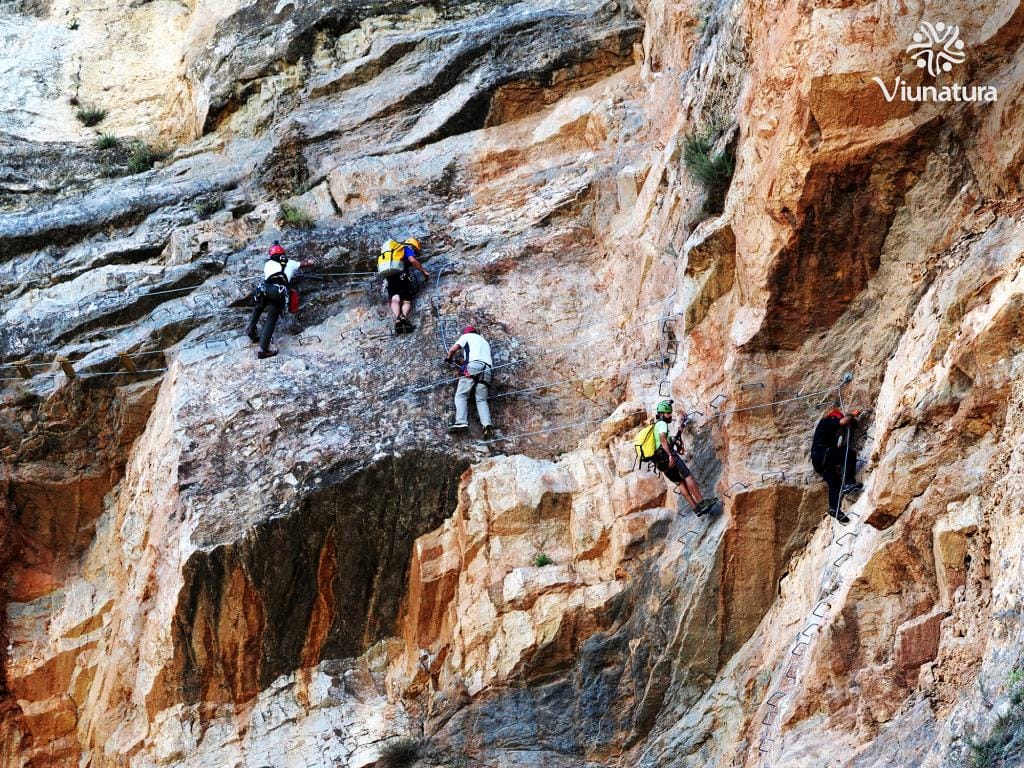
Discovering the best vias ferratas in the interior of Castellón
The Region of Valencia has many limestone peaks and mountains packed with cavities, cracks and grooves from the effects of weathering and erosion on the rock. It's a real paradise for climbing enthusiasts. However, if you're still taking your first steps in this sport or you want to enjoy a more controlled and less physically demanding form of climbing, but without missing out on amazing landscapes and getting your adrenaline fix,we suggest you have a go at doing a via ferrata.
In this post we tell you about three vias ferratas in the interior of Castellón that stand out for their special beauty and the good condition of the equipment fixed to the rock:
- Ferrata La Cantera de Vilavella (Castellón)
La Vilavella is a town that serves as a gateway to the Sierra de Espadán mountain range from the area of La Plana de Castellón. It's a very hospitable town with around 3,000 inhabitants. It's also the start of the GR 36 footpath, also known as the TransEspadán, a hiking trail that crosses the mountain range and runs to Montanejos.
The via ferrata has been set up in the town's old quarry, where rocks were quarried to build what's now the breakwater in the port of Burriana. The via ferrata is also inside the municipal sports complex, making it a semi-urban one. The views from the top allow you to see over the orange and clemenules orchards all the way to the Mediterranean Sea as backdrop.
La Cantera via ferrata was equipped in 2017 to K2-K3 level. It is reached with no need to hike and takes about 45 minutes (20 minutes for the return journey). It's 130 metres in length, split into 6 sections that take you over a height gain of 100 metres.
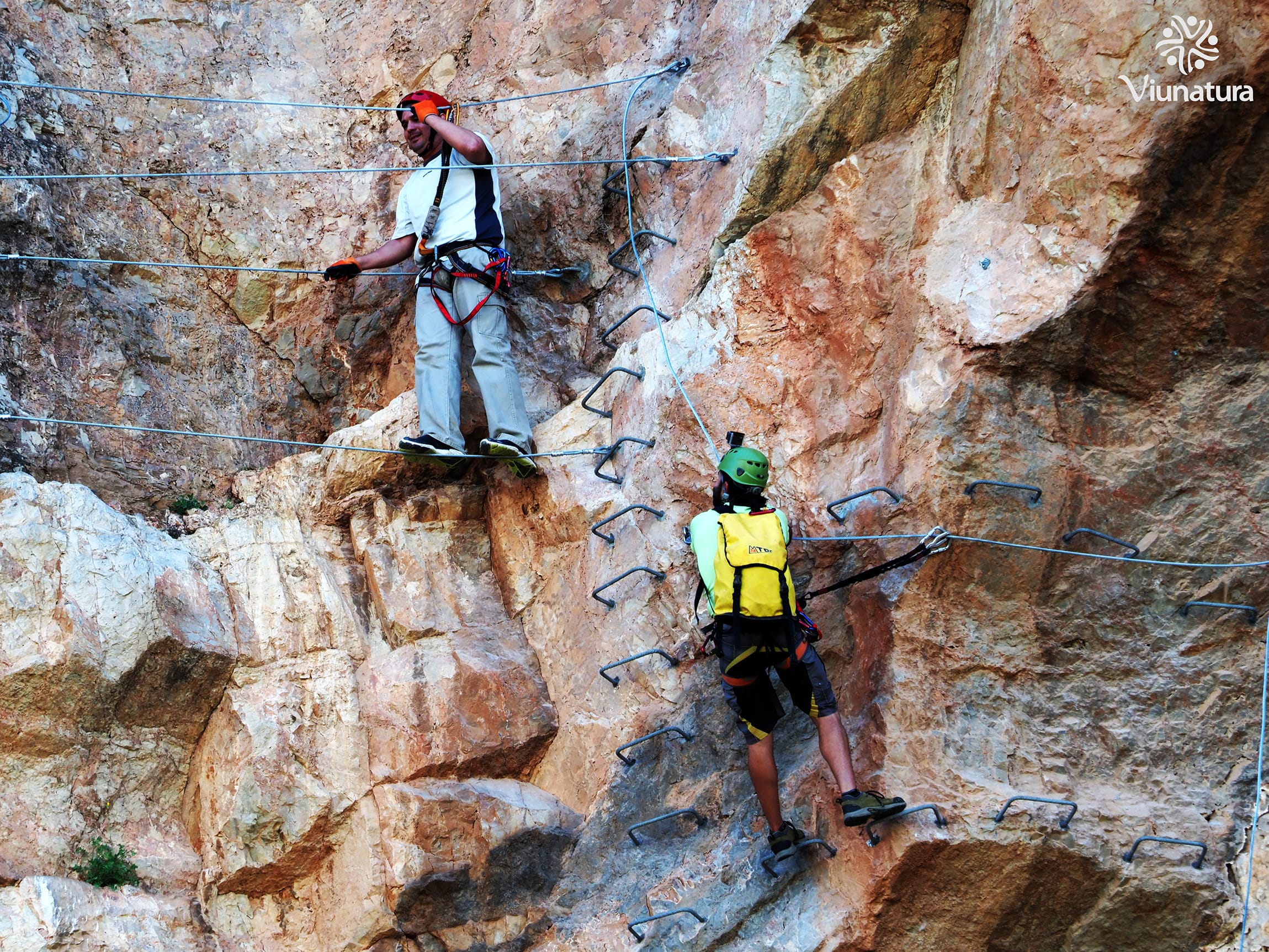
- SECTION 1: You clip onto the safety cable and climb up a fairly gentle section, climbing over two big rock steps with the help of a few steps until you reach the almost vertical start.
- SECTION 2: Now you start to climb using the iron rungs provided for feet and hands as you start gaining height.
- SECTION 3: You now have to move around an overhang and this is done by traversing a drop using the iron rungs provided for feet and hands that lead to a small Tibetan bridge. This is the start of the exposed sections.
- SECTION 4: Once you have crossed the Tibetan bridge, you begin a long traverse to the left and a short way in you'll come across a walkway with blocks of wood that allow you to enjoy the height gained in the climb.
- SECTION 5: You complete the traverse and tackle another vertical climb with small overhangs and sideways steps that really make you use your arms.
- SECTION 6: You'll find a chain that takes you to the set of wooden steps, progress is easier and this area means you can enjoy the views from this spot comfortably while you hold on to the chain. Follow the chain to get to the top.
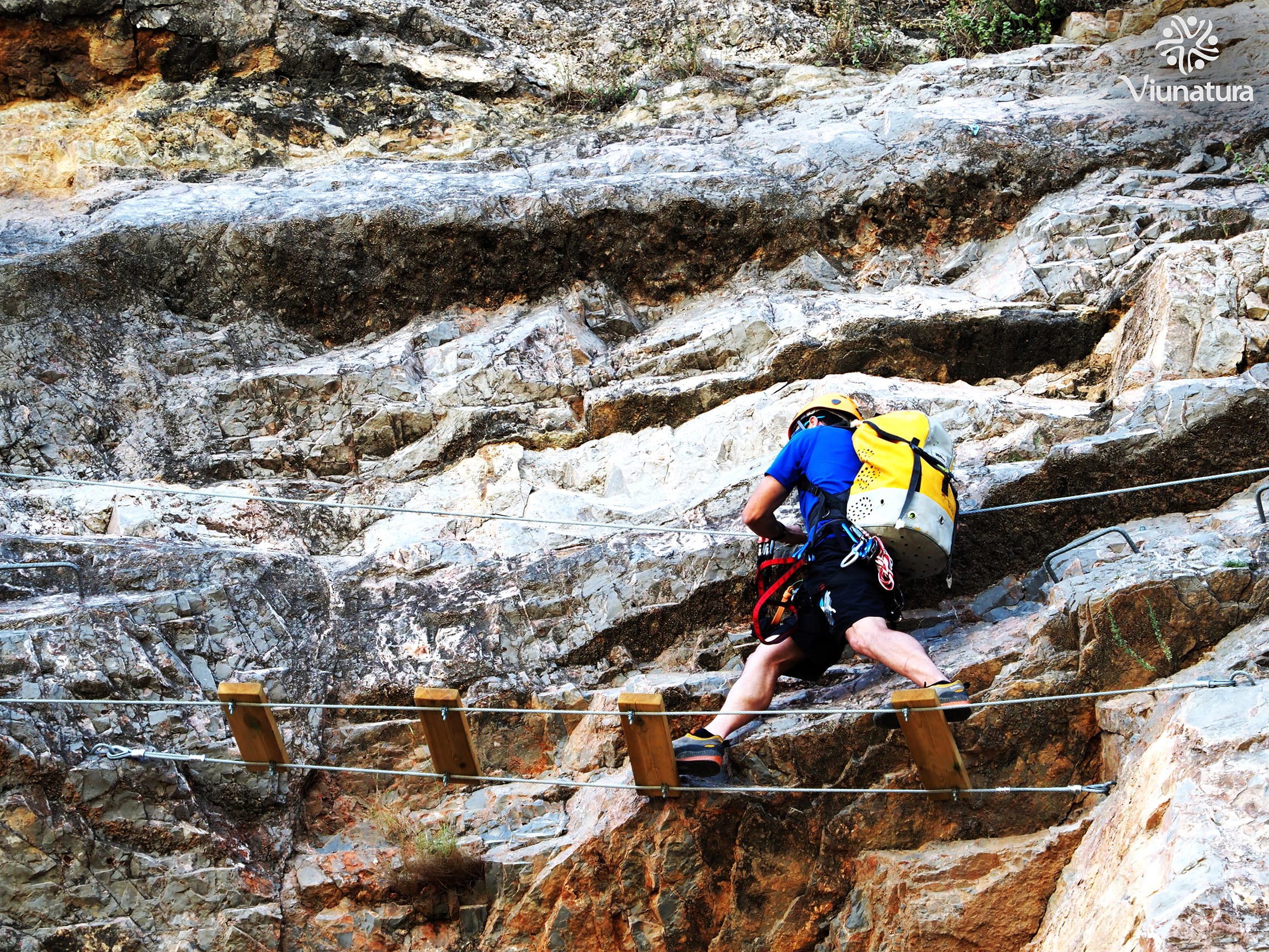
This via ferrata also gives you the option of descending from the end of the horizontal traverse section by abseiling down over a large dome of rock. To do this you descend from the end of the traverse using the rungs provided that run underneath an overhang. There you'll find a hook with two rings, as well as several parabolts with plates for fitting the abseil rope easily. There's also a wooden log that's been treated to prevent ropes from rubbing against the rock face. The abseil set up also allows several people to be anchored if the activity is being done with an adventure tourism company.
The abseil has a total height of 24 metres from the set-off point and there is a handrail cable at the bottom that serves as a lifeline to get back to the start of the via ferrata.
- La Muela via ferrata in Villahermosa del Río (Castellón)
Villahermosa del Río is on the flank of a hill at the confluence of the Carbo and Villahermosa rivers. Together with the towns of Vistabella and Xodos, this town, set in an area of rugged mountains, is part of the Parque Natural del Penyagolosa nature reserve, a mecca for hikers and traditional culture in the Region of Valencia.
Although the town's main source of income is livestock farming, natural products and crafts, the municipal area's extraordinary natural setting means that nature tourism is taking on an increasingly greater role as another source of income, helping the town in the struggle against the depopulation affecting many of the towns and villages deep inland. In this case, the town has gone from almost 2,800 inhabitants in the early 20th century to barely 500 today.
Villahermosa del Río town council is very keen to promote and improve its local nature tourism provision, already an important feature of the surrounding area, and took the decision to open a via ferrata as an access route to the steepest part of the town from the Carbo river as its flows through the gorge of La Hoz.
The via ferrata of La Muela was equipped in 2014 with a level of K2-K3. The route is reached with no need to hike and takes about one hour (30 minutes for the return journey on foot along the road). It's 143 metres in length, split into 5 sections that take you over a height gain of 95 metres.
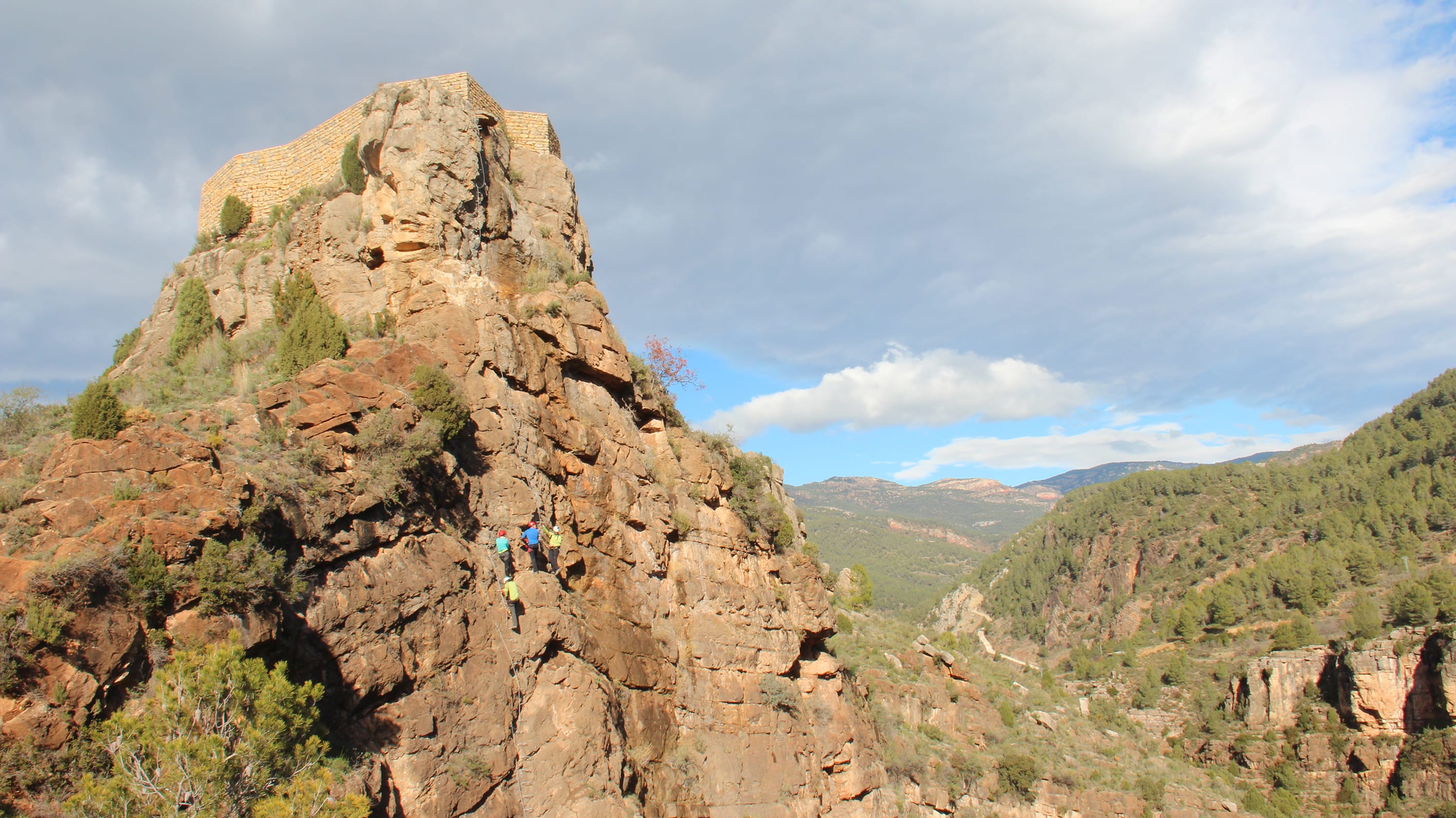
- SECTION 1. The access path takes you to the rock face where you'll find the steel cable that you must clip on to traverse the next 20 metres horizontally until you reach the first vertical section at the height of around 20 metres. After climbing the first vertical section, you reach a long ledge.
- SECTION 2. After walking along this broad ledge, which is about 18 metres long and equipped with a chain handrail, you come to the most difficult section of this via ferrata, a short traverse that is enough of an overhang to demand a fair amount of arm work. After this tricky section, the next 20 vertical metres are less exposed and overhanging until you reach the convenient ledge that marks the end of the section.
- SECTION 3. After walking along this ledge, you reach a pitch with a vertical line that runs diagonally from left to right for 22 metres, a slightly more comfortable stretch than the previous one, but no less technical. This section finishes on another horizontal traverse.
- SECTION 4. This horizontal traverse equipped with iron footholds takes you to another ledge, which is undoubtedly a good place for enjoying the amazing views over the gorge of La Oz (Carbo river). From this ledge you climb the 15 vertical metres that separate you from the final ledge, where you can take a breather before the final push to the top of La Muela.
- SECTION 5. Along the 10 vertical metres on the last section before the top of La Muela, there is enough of an overhang on the rock face to demand a significant effort. This via ferrata ends after passing the wall of the viewpoint on top of La Muela, so you can take your time to admire the breathtaking panorama before walking back to the start through the streets of Villahermosa del Río.
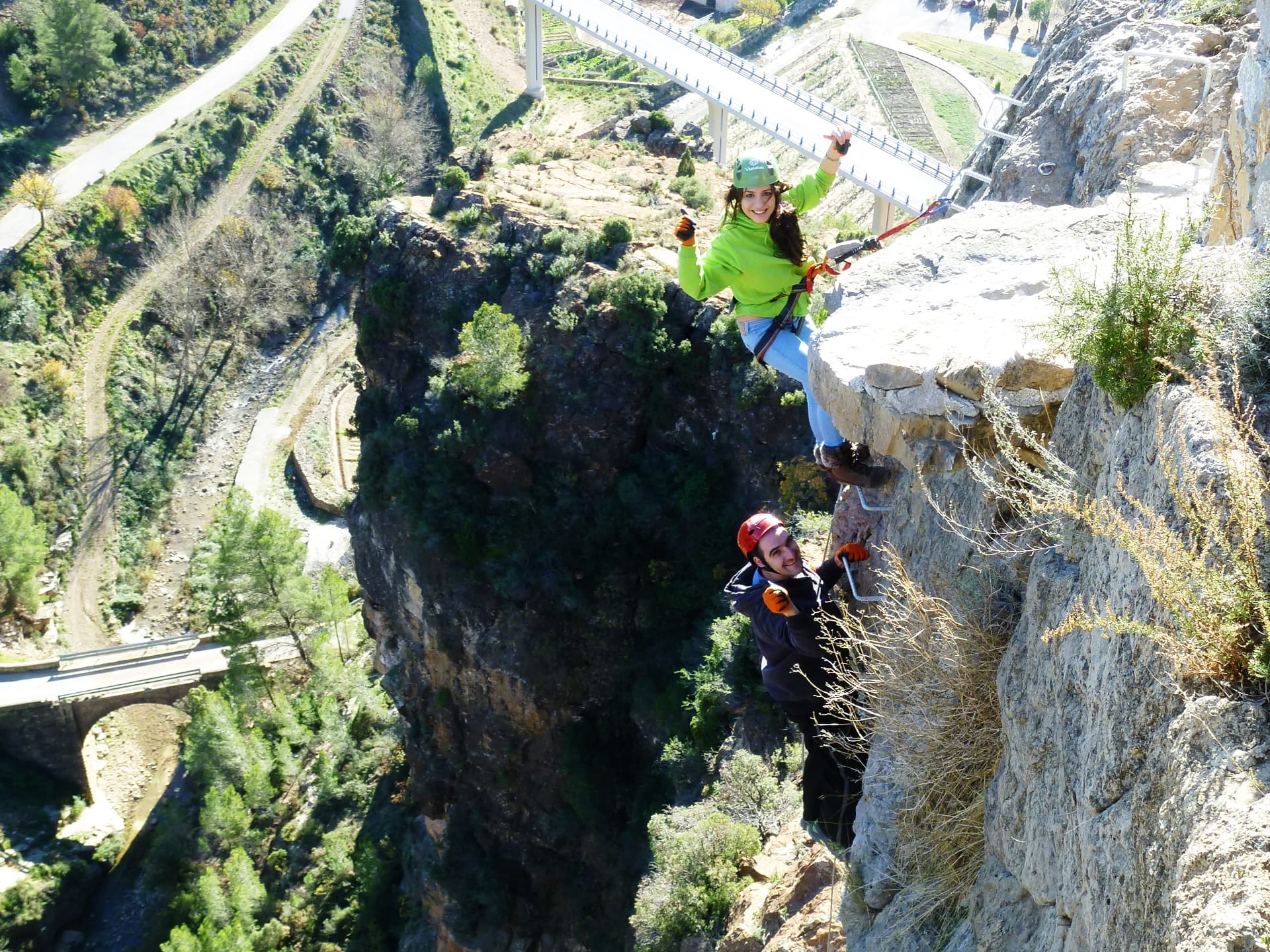
- La Roca del Molí via ferrata in L’Alcora (Castellón)
The final via ferrata we suggest you try is in L'Alcora, a town known all over the world for its ceramic industry, the area's main economic driver. But this region offers much more, natural and uniquely beautiful landscapes that are still unknown, even by most of the people who live around here.
One of these spots is Embalse de Alcora, a small reservoir surrounded by leafy vegetation typical of Mediterranean river bank forest with huge natural and landscape value, where you can also find attractions with great historical and cultural value like the Conde de Aranda mill that stands right next to the dam. It's right here, on a rocky outcrop next to the mill, that you'll see La Roca del Molí, a simple via ferrata suitable for beginners wanting to enjoy the countryside.
La Roca del Molí via ferrata was equipped in 2013 with a level of K1. To get here you have to walk around 10 minutes and the via ferrata takes about 30 minutes (10 minutes for the return trip). It's 50 metres in length, split into 3 sections that take you over a height gain of 50 metres. As well as the vertical ascent, there is also a 50 metre zip line and the option of doing a 10 metre abseil for to get back to the start.
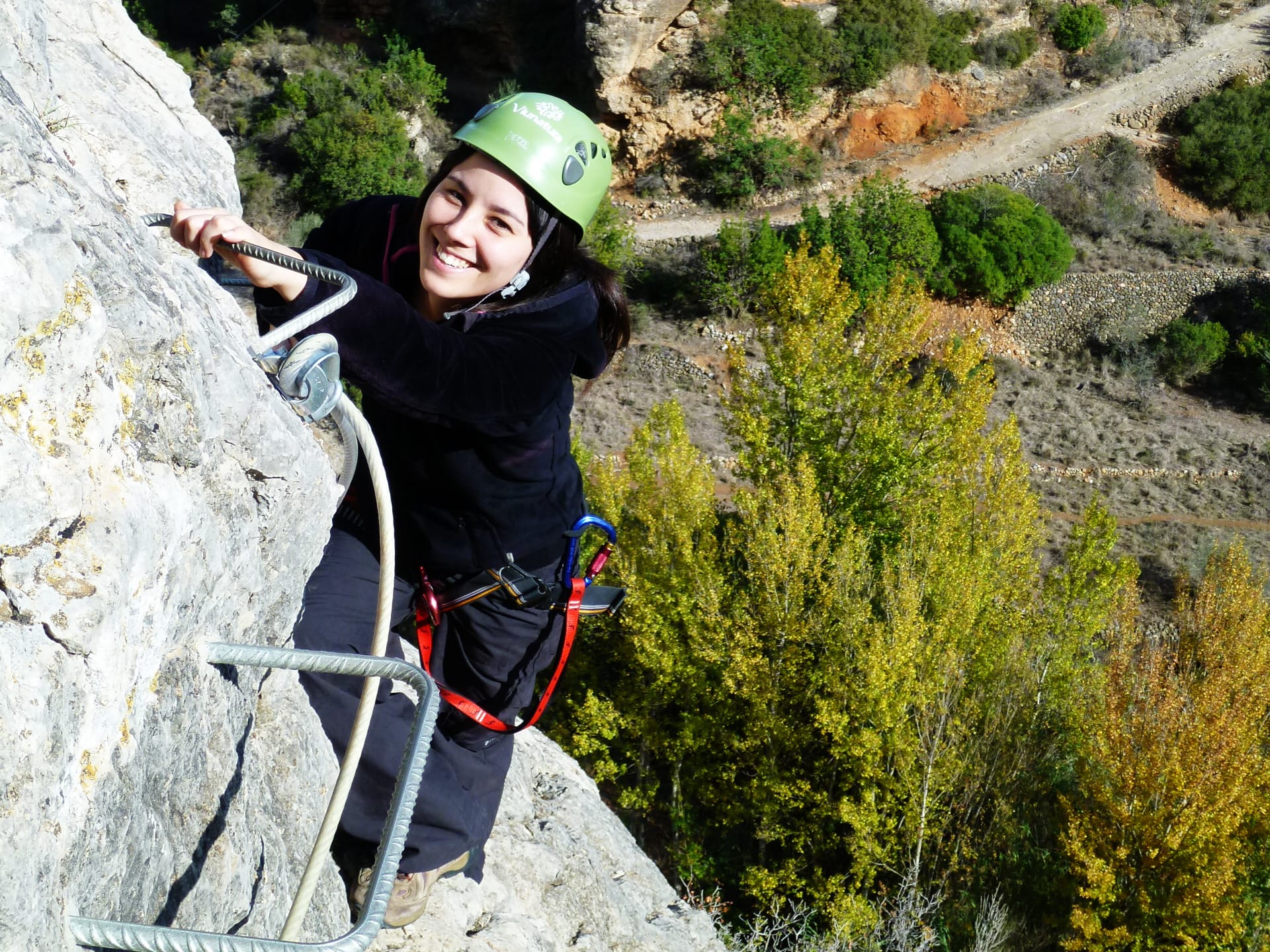
- SECTION 1. The first section of the via ferrata starts with a vertical pitch about 20 metres high, after which the climb continues less steeply until you reach a height of 35 metres.
- SECTION 2. After the first vertical section there is a horizontal traverse of about 7 metres in length equipped with a lifeline and a few rungs.
- SECTION 3. After the horizontal section, you reach the final vertical section of projecting rocks that takes you to the top of the boulder, where you'll find the beginning of the 50 metre zipline.
- ZIPLINE: The 50 metre long zipline with its steel cable is optional.
- ABSEIL: Whether you do the zipline or not, you can also descend to the foot of the via ferrata along the trail leading off to the right of the boulder, or you can opt to abseil from the anchor point situated on the left of the boulder at around 15 metres high.
Although doing these vias ferratas is less risky than traditional climbing, like any other mountain or adventure activity they are not without their dangers and you are advised to exercise maximum precaution and use full safety gear. The ideal way of doing them is with an adventure tourism company offering all the guarantees and experience you'd expect for having an enjoyable and exciting day out.
We're grateful for the photographs and information provided by Viu Natura, an adventure tourism company working in the area that has also been responsible for equipping some of the local vias ferratas.
